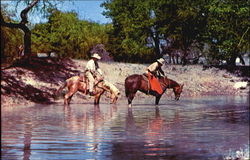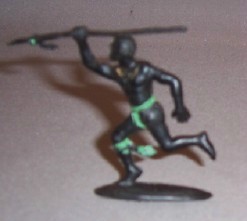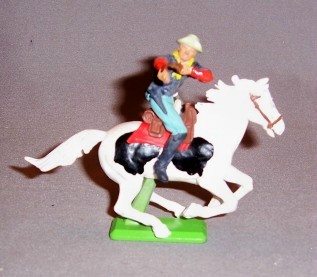The following day Rabih gathered his forces, and ordered 100 lashes be given to all his bannermen, including his own favored son Fadlallah. Only Boubakar, who had fought bravely, was spared. Then he ordered a victorious counter-offensive; Kiyari, who had refused to flee, was captured and beheaded. As for the capital city, Kukawa, it was plundered and razed to the ground.
Rabah made Dikoa his capital, and there built a palace which was to won later the admiration of the French governor Émile Gentil.
[edit] Bornu's Lord (1893–1900)Wanting to modernize his army, Rabih and attempted in 1895 to make an accord with British Royal Niger Company in Yola and Ibi so to obtain gunpowder and ammunition, but without success. He started confronting the British in 1896 and the following year even started marching on Kano, while his vassal Muhammad ibn Ali as-Senussi founded a fortified capital, Ndele, between Bahr Aouk and the Ubangi River, which he held until 1911.
For seven years Rabih was shehu of the Bornu Empire, and spent much effort to reinvigorate a decadent empire that had until then maintained the same feudal structures it had in the 16th century. Rabih kept the vassal sultans in place, but subjected them to his lieutenants, mostly Arab Sudanese like him.
He promulgated a legal code based on the sharia, rationalized taxation through the creation of a budget, imposed on Bornu a military dictatorship, which aroused the attention of the colonial powers. Émile Gentil was to speak of Rabih's reforms in Bornu with a certain degree of interest; they would later inspire him in organizing the territory of Chad.
Much is told about his brutality (for example, he once had one of her concubines executed because she kept a talisman designed to obtain Rabih's love, and with her the marabout that had deciphered the talisman); or about the evenings he passed listening to Ali, the poet who sang his exploits.
More importantly, Rabih launched a regular series of razzias to plunder and capture slaves; this was a return to the traditional activity of the sultans of Bornu, which had been described in 1526 by Leo Africanus. It is estimated that 1500–2000 slaves were exported every year by his vassal Mohammed ibn Ali as-Senoussi, excluding the deaths, casualties, and other losses he inflicted. The totals for Rabah must have been much higher.
Battle of Kousséri
In 1899 Rabah had at his disposal 10,000 men among infantry and cavalry, all provided with rifles (mostly obsolete, except for 400 rifles of newer make), plus a great number of auxiliaries equipped with lances or arcs. He kept garrisons at Baggara and Karnak Logone.
In 1899, Rabih received in Dikoa the French explorer Ferdinand de Béhagle. The talks between them degenerated, and Béhagle was arrested. On July 17, Lieutenant Bretonnet, who had been sent by France against Rabih, was killed with most of his men at Togbao, at
The talks between them degenerated, and Béhagle was arrested. On July 17, Lieutenant Bretonnet, who had been sent by France against Rabih, was killed with most of his men at Togbao, at  the edge of the Chari River, in present-day Sarh. Rabih gained three cannons from this victory (which the French recaptured at Kousséri) and ordered his son Fadlallah, who he had left in Dikoa, to hang Béhagle.
the edge of the Chari River, in present-day Sarh. Rabih gained three cannons from this victory (which the French recaptured at Kousséri) and ordered his son Fadlallah, who he had left in Dikoa, to hang Béhagle. In response, a French column proceeding from Gabon and led by Émile Genti l, supported by the steamboat Leon Blot, confronted Rabih at Kouno at the end of the year.
Even if the French were repulsed with losses, this did not prevent them from continuing and taking Kousséri. Here, they combined with the Lamy column, which had arrived from Algeria, and the Joalland-Meynier column, which had marched from Niger. Lamy assumed command of the combined forces.
l, supported by the steamboat Leon Blot, confronted Rabih at Kouno at the end of the year.
Even if the French were repulsed with losses, this did not prevent them from continuing and taking Kousséri. Here, they combined with the Lamy column, which had arrived from Algeria, and the Joalland-Meynier column, which had marched from Niger. Lamy assumed command of the combined forces. The final showdown between Rabih and the French took place on April 22, 1900. The French forces disposed of 700 men, plus the 600 riflemen and 200 cavalry provided by the allied Baguirmians. Leaving Kousséri in three columns, the French attacked Rabih's camp. Although the commander Lamy was killed in the ensuing battle, Rabih's forces were overwhelmed and, while fleeing across the Chari River, Rabih was killed.
With Rabih's defeat, his empire rapidly disintegrated. A year later his son Fadlallah was defeated and killed, while his chief vassal, Mohammed al-Senussi, was murdered in 1911 at French instigation. All Rabih's territories fell into French hands, except for Bornu which went to Britain





 here is the Royal Horse Artillery Drivers Tunic Circa 1815
here is the Royal Horse Artillery Drivers Tunic Circa 1815 Royal Horse Artillery
Royal Horse Artillery 



 moved from Illinois to an area in Texas near the Navasota River.
moved from Illinois to an area in Texas near the Navasota River. The group built large walls around the settlement as protection from the nearby tribes of Native Americans, and the settlement became known as Fort Parker
The group built large walls around the settlement as protection from the nearby tribes of Native Americans, and the settlement became known as Fort Parker 

 residents of the fort, including the Elder John Parker and Silas Parker, the father of Cynthia Ann. Five captives
residents of the fort, including the Elder John Parker and Silas Parker, the father of Cynthia Ann. Five captives  were taken during the attack including Cynthia Ann and her brother John.
were taken during the attack including Cynthia Ann and her brother John.
 and also not uncommon was the use of ransom for return,
and also not uncommon was the use of ransom for return,  After the Fort Parker kidnappings, most of the captives were eventually returned for ransom, but Cynthia Parker, who was 9 at the time, remained with the Comanch
After the Fort Parker kidnappings, most of the captives were eventually returned for ransom, but Cynthia Parker, who was 9 at the time, remained with the Comanch


 tribe abandoned him in Mexico, where he regained his health and began living
tribe abandoned him in Mexico, where he regained his health and began living with people there. It is thought that he later returned to Texas and fought in the Civil War
with people there. It is thought that he later returned to Texas and fought in the Civil War
 and Pecos, and one girl named Topsannah, also known as Prairie Flower.
and Pecos, and one girl named Topsannah, also known as Prairie Flower. 
 differ. John Henry Brown says Ross’ attack was provoked by attacks from Peta Nocona and the other Comanche warriors on white settlements.
differ. John Henry Brown says Ross’ attack was provoked by attacks from Peta Nocona and the other Comanche warriors on white settlements. 

 society, and Cynthia died in 1870 from a combination of self-imposed starvation and the flu.the piece above is easily convertible to comanche indians, its by charbens
society, and Cynthia died in 1870 from a combination of self-imposed starvation and the flu.the piece above is easily convertible to comanche indians, its by charbens
 and the last chief of the Quahada Comanche. In his early years as a warrior, Quanah Parker was known to attack and raid white buffalo hunters and settlers.
and the last chief of the Quahada Comanche. In his early years as a warrior, Quanah Parker was known to attack and raid white buffalo hunters and settlers. 



 he first served with the irregular Egyptian cavalry in the Ethiopian campaign, during which he was wounded.
he first served with the irregular Egyptian cavalry in the Ethiopian campaign, during which he was wounded. 

 skirmish wargaming group photo, check them out.
skirmish wargaming group photo, check them out.


 the edge of the Chari River, in present-day Sarh.
the edge of the Chari River, in present-day Sarh.  l, supported by the steamboat Leon Blot, confronted Rabih at Kouno at the end of the year.
l, supported by the steamboat Leon Blot, confronted Rabih at Kouno at the end of the year.











